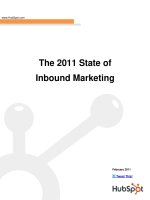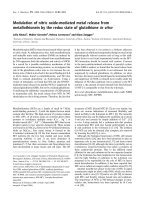The 2011 State of Inbound Marketing
Bạn đang xem bản rút gọn của tài liệu. Xem và tải ngay bản đầy đủ của tài liệu tại đây (575.72 KB, 19 trang )
The 2011 State of
Inbound Marketing
www.HubSpot.com
February 2011
Tweet This!
THE STATE OF INBOUND MARKETING
HubSpot.com
2
Contents
Introduction 3
The State of Marketing Costs & Budgets 4
Inbound Channels Convert Leads into Customers 10
What‘s Important to Marketers? 13
Conclusion and Additional Resources 16
Appendix 17
THE STATE OF INBOUND MARKETING
HubSpot.com
3
Introduction
Summary
This report is based on a January 2011 survey of 644 professionals familiar with their business‘
marketing strategy.
1
The key takeaways are:
Inbound marketing channels are maintaining their low-cost advantage: Inbound
marketing-dominated organizations experience a cost per lead 62% lower than outbound
marketing-dominated organizations.
The gap between spending on inbound vs. outbound continues to widen: In 2009,
inbound marketing had a 9% greater share of the lead generation budget; in 2011 its share
was 17% greater.
Blogs and social media channels are generating real customers: 57% of companies
using blogs reported that they acquired customers from leads generated directly from their
blog.
More and more business are blogging: Businesses are now in the minority if they do not
blog. From 2009 to 2011 the percentage of businesses with a blog grew from 48% to 65%.
Businesses are increasingly aware their blog is highly valuable: 85% of businesses
rated their company blogs as ―useful,‖ ―important‖ or ―critical;‖ a whopping 27% rated their
company blog as ―critical‖ to their business.
Overview of Inbound Marketing
This report is designed to help businesses and marketers understand the current usage and results of
inbound marketing. Inbound marketing is a set of marketing strategies and techniques focused on
pulling relevant prospects and customers towards a business and its products. Inbound marketing is
becoming widely accepted because it complements the way buyers make purchasing decisions
today—they are using the Internet to learn about the products and services that best meet their needs.
Inbound marketers offer their audiences useful information and tools to attract these people to
their site, while also interacting and developing relationships with individuals on the Web. Inbound
marketing tools include blogging, content publishing, search engine optimization and social media.
Inbound marketing contrasts with traditional outbound marketing, in which businesses push their
messages at consumers. With techniques that include direct mail, telemarketing and trade shows,
outbound marketing has become less effective over time as buyers have behaviorally and
technologically (e.g., TIVO, spam filters, ‗do-not-call‘ lists) tuned these interruptive campaigns out.
1
For more information about the survey please see the appendix.
THE STATE OF INBOUND MARKETING
HubSpot.com
4
The State of Marketing Costs & Budgets
Inbound Consistently Delivers a Cost per Lead Dramatically Lower Than Outbound
Survey participants were asked to report the distribution of their spending and their average cost per
lead. Respondents who spend more than 50% of their lead generation budget on inbound marketing
channels report a significantly lower cost per sales lead than those who spend 50% or more of their
budgets on outbound marketing channels:
In 2011, the average cost per lead for outbound-dominated businesses was $373, while
inbound businesses reported their leads cost on average $143.
Inbound marketing-dominated organizations experience a 62% lower cost per lead
than outbound marketing dominated organizations.
This finding is remarkably consistent from year to year. The previous study showed strikingly similar
results: the 2010 survey showed that inbound marketing-centric organizations experienced a 60% lower
cost per lead.
$332
$373
$134
$143
$0
$200
$400
2010
2011
Avg. Cost per Lead
Average Cost Per Lead
Inbound vs. Outbound
Outbound Marketing
Dominated
Inbound Marketing
Dominated
62% Lower Cost per Lead
THE STATE OF INBOUND MARKETING
HubSpot.com
5
Three Out of Four Inbound Channels Cost Less than Any Outbound Channel
When asked to classify each lead generation category as ―below average cost,‖ ―near average cost,‖ or
―above average cost,‖ businesses consistently ranked inbound marketing channels as having costs
lower than outbound channels. PPC was the only inbound channel that was ranked among the
outbound channels.
Blogs, social media and organic search maintained the top slots as least expensive.
Blogs had the highest instance of being reported as ―Below Average Cost:‖ 55% of
companies who blog indicated leads from this channel were ―Below Average Cost.‖
Trade shows, PPC, direct mail and telemarketing were most frequently ranked as more
expensive.
55%
47%
39%
36%
33%
27%
19%
0%
20%
40%
60%
Blogs
Social Media
SEO
(Organic
search)
Telemarketing
Direct Mail
PPC
(Paid
search)
Trade
Shows
% of Respondents
Below Average Cost per Lead,
% Respondents by Lead Channel
47%
29%
27%
21%
13%
13%
9%
0%
20%
40%
Trade Shows
PPC
(Paid
search)
Direct Mail
Telemarketing
SEO
(Organic
search)
Social Media
Blogs
% of Respondents
Above Average Cost per Lead,
% Respondents by Lead Channel
Outbound
Inbound
Channle
Outbound
Inbound
Majority reported blog leads are cheaper.
Trade Shows were most frequently
reported as more expensive than average
THE STATE OF INBOUND MARKETING
HubSpot.com
6
The Majority of Businesses Are Increasing Their Inbound Marketing Budgets
―How does your 2011 Inbound Marketing budget compare to your 2010 budget?‖ the survey asked. ―If
your 2011 inbound marketing budget changed from your 2010 budget, what drove that decision?‖ The
answers to these questions show that the majority of businesses are consistently increasing inbound
marketing budgets:
54% of those surveyed are increasing their inbound marketing budgets.
89% are either maintaining or increasing their inbound marketing budgets.
This increase was observed two years in row.
Among the 54% of respondents with increased inbound marketing budgets, the most
commonly cited reason was ―past success with inbound marketing.‖
The majority of businesses attributed their decreasing budgets to the ―economic
conditions‖ (71%) or ―a change in management‖ (15%).
51%
37%
12%
54%
35%
11%
0%
20%
40%
60%
Higher
No Change
Lower
% of Respondents
How does your Inbound Marketing budget for the current year
compare to your budget for the previous year?
2010
2011
0%
14%
15%
21%
50%
0% 20% 40%
Past Success
with Outbound
Change in
Management
Economy
Other
Past Success
with Inbound
% of Respondents
Why Businesses are Increasing
Inbound Budgets
0%
3%
11%
15%
71%
0% 25% 50%
Past Success
with Inbound
Past Success
with Outbound
Other
Change in
Management
Economy
% of Respondents
Why Businesses are Decreasing
Inbound Budgets
Majority reported increases in inbound
budgets two years in a row.
THE STATE OF INBOUND MARKETING
HubSpot.com
7
Distribution of Budgets Continues to Shift To Inbound Channels
We asked survey respondents what percentage of their lead generation budgets would be spent on
each of 9 marketing channels: ―direct mail,‖ ―telemarketing,‖ ―trade shows,‖ ―email marketing,‖ ―PPC
(paid search / AdWords),‖ ―SEO (organic / natural search),‖ ―social media,‖ ―blogs,‖ and ―other.‖ Those
nine channels were grouped as follows (email marketing can be used both as an inbound and an
outbound marketing tool so it was not classified):
INBOUND CHANNELS
OUTBOUND
CHANNELS
NOT
CLASSIFIED
PPC
Direct Mail
Email Marketing
SEO
Telemarketing
Other
Social Media
Trade Shows
Blogs
The results show that:
The average portion of budget dedicated to inbound increased from 38% to 41% from 2009
to 2011.
The net effect is that the gap continues to widen - inbound marketing had a 9% greater
share of the lead generation budget in 2009 in comparison to a 17% greater share in
2011.
29%
24%
38%
41%
0%
20%
40%
2009
2011
Avg % of Budget
Lead Generation Budget
Average Distribution, 2009 v. 2011
Outbound
Inbound
9% gap
17% gap
THE STATE OF INBOUND MARKETING
HubSpot.com
8
A more granular view of the data shows that:
Marketers are allocating more of their lead generation budgets to social media and company
blogs.
The average budget spent on company blogs and social media increased from 9% in 2009 to
17% in 2011.
Marketers are decreasing the portion spent on PPC, direct mail and telemarketing.
9%
15%
18%
13%
13%
13%
16%
11%
10%
0%
10%
20%
30%
40%
50%
2009
2010
2011
Avg % of Budget
Inbound Lead Generation Budget
Average Distribution, 2009-2011
PPC
SEO (organic
search)
Blogs & Social
Media
9%
7%
6%
11%
11%
13%
10%
6%
5%
0%
20%
40%
2009
2010
2011
Avg % of Budget
Outbound Lead Generation Budget
Average Distribution, 2009-2011
Telemarketing
Trade Shows
Direct Mail
THE STATE OF INBOUND MARKETING
HubSpot.com
9
Small Companies Continue to Spend More of Their Budgets on Inbound Marketing
In a continuation of a trend identified in previous reports, small businesses are attempting to level the
playing field by focusing on lower-cost inbound lead generation techniques.
In 2011, small businesses (1 to 5 employees) plan to spend 49% of their lead generation
budgets on inbound marketing.
In comparison, medium-to-large businesses (50 or more employees) only plan to spend 36% of
their lead generation budgets on inbound marketing.
Small business are only giving 10% of their budget to outbound, while medium-to-large
business are allocating 28% of their budget to outbound channels.
Small businesses plan to spend dramatically more of their budgets on social media and blogs.
Medium-to-large businesses plan to spend more of their budgets on outbound methods,
including trade shows, direct mail and telemarketing.
19%
16%
10%
12%
4%
3%
3%
3%
6%
17%
3%
13%
13%
10%
7%
8%
0%
10%
20%
Social Media
SEO
(Organic
Search)
Blogs
Marketing
Trade Shows
PPC
(Paid Search)
Direct Mail
Telemarketing
Avg % of Budget
Avg. Distribution of Lead Generation Budgets
Small vs. Medium to Large Businesses
1 to 5 Employees
Over 50 Employees
THE STATE OF INBOUND MARKETING
HubSpot.com
10
Inbound Channels Convert Leads into Customers
Social Media and Blogs Generate Real Customers
The use of social media and company blogs as marketing tools not only gets your company better
brand exposure, but it also generates leads that result in real customer acquisition.
57% of those using company blogs have acquired a customer from a blog-generated lead;
this is an increase of 11 percentage points since 2010.
Similarly, 57% of companies using LinkedIn have acquired a customer from that channel.
Facebook and Twitter users reported customer acquisition rates of 48% and 42%,
respectively.
Customer Acquisition through Blogs is Directly Related to Frequency of Posts
If your blog is underutilized, you are leaving customers on the table. The 2011 survey shows a direct
correlation between blog post frequency and new customers acquired.
46%
41%
44%
41%
57%
57%
48%
42%
0%
20%
40%
60%
Company Blog
% of Channel
Users who
Acquired a
Customer
Through that
Channel
Customer Acquisition by Channel
2010
2011
33%
49%
72%
76%
78%
89%
0%
50%
100%
Less Than
Monthly
Monthly
Weekly
2-3 Times
a Week
Daily
Multiple
Times a
Day
% of BlogUsers
who Acquired
a customer
through
their blog
Frequency of Blog Posts
Blog Post Frequency vs. Customer Acquisition
THE STATE OF INBOUND MARKETING
HubSpot.com
11
Most Company Blogs Publish at Least Weekly
Despite the evidence showing that increased blogging correlates with increased customer acquisition,
blogging frequency remained relatively steady between 2009 and 2011.
In 2011, 71% of respondents indicated they blog at least weekly.
Facebook Is More Effective for B2C; LinkedIn Is More Effective for B2B
The effectiveness of a particular social media channel depends upon the type of business. While both
B2B and B2C companies are able to acquire customers through any of the four channels surveyed,
Facebook is clearly more effective for B2C businesses and LinkedIn is clearly more effective for B2B
businesses. Both business types found similar and relatively high success with customer acquisition
through a company blog.
15%
62%
23%
10%
61%
29%
0%
20%
40%
60%
80%
Daily
Weekly
Monthly or less
% of Repsondents
Frequency of Blog Posts
2009 v. 2011
2009
2011
61%
55%
41%
39%
39%
63%
67%
53%
0%
20%
40%
60%
80%
Company Blog
% of Channel
Users who
Acquired a
Customer
Through
that Channel
Customer Acquisition by Channel
B2B v. B2C
B2B
B2C
THE STATE OF INBOUND MARKETING
HubSpot.com
12
Channel Effectiveness by Industry
A deeper dive into the customer acquisition results shows how the effectiveness of blogs, Twitter,
Facebook and LinkedIn varies by industry. The major takeaways from this data include:
Higher Education, Professional Services & Consulting, and Software & Biotech found blogging
was highly effective. All of those industries had over 50% of respondents indicating customer
acquisition through their blog.
The Retail industry experienced the most success through Facebook and Twitter.
Communications & Media, Banking/Insurance/Financial Services, Manufacturing, Professional
Services & Consulting, and Technology Hardware found LinkedIn was highly effective.
58%
58%
80%
72%
50%
59%
60%
66%
61%
0% 20% 40% 60% 80% 100%
Technology (Software/Biotech)
Technology (Hardware)
Retail/Wholesale
Professional Services/Consulting
Manufacturing
Higher Education
Communications/Media
Banking/Insurance/Financial Services
% of Channel Users who Acquired a Customer
Through that Channel
Customer Acquisition by Channel
by Industry
Blog
THE STATE OF INBOUND MARKETING
HubSpot.com
13
What’s Important to Marketers?
Inbound Marketing Channels Continue to Grow in Importance
Based on the data regarding customer acquisition and lower average costs for inbound marketing, it is
not surprising that inbound marketing channels continue to grow in importance. Looking at the last six
months:
62% of businesses rated social media as being more important.
Social media and SEO were the channels most frequently reported as MORE important.
Direct mail was the channel most frequently cited as LESS important.
Businesses rated every outbound channel as LESS important than any inbound channel.
62%
51%
38%
22%
16%
11%
10%
0%
10%
20%
30%
40%
50%
60%
70%
Social Media
SEO
(Organic
search)
Blogs
PPC
(Paid search)
Trade Shows
Telemarketing
Direct Mail
% of Respondents
Which sources of leads have become MORE
important to you over the last six months?
50%
38%
33%
25%
12%
10%
7%
0%
10%
20%
30%
40%
50%
60%
Direct Mail
Trade
Shows
Telemarketing
PPC
(Paid
search)
Blogs
SEO
(Organic
search)
Social Media
% of Respondents
Which sources of leads have become LESS
important to you over the last six months?
Outbound
Inbound
Outbound
Inbound
THE STATE OF INBOUND MARKETING
HubSpot.com
14
Blogs Remain Most Important Social Media Channel
Survey respondents were asked to indicate if their
business publishes a blog. From 2009 to 2011, the
volume of respondents indicating that their
company publishes a blog has shown rapid
growth:
From 2009 to 2011, the percentage of
respondents with a company blog grew
from 48% to 65%.
On the flip side, the likelihood of a not
having a blog has been reduced from 52%
to 35%.
Respondents were also asked to rank the services that they use as ―critical,‖ ―important,‖ or ―useful.‖
The results indicate:
A whopping 27% of users rated their company blog as “critical” to their business.
85% of users rated company blogs as “useful” or better.
LinkedIn, YouTube, Facebook and Twitter were considered ―useful‖ or better by over 60%.
In contrast, MySpace, StumbleUpon, Digg and Flickr all had user bases where over 70%
considered the channel only ―somewhat useful‖ or ―not useful.‖
14%
18%
14%
16%
27%
25%
26%
30%
34%
35%
25%
23%
28%
21%
23%
0% 20% 40% 60% 80% 100%
MySpace
StumbleUpon
Digg
Flickr
YouTube
Company Blog
% of Users
How important are these services to your business?
Critical
Important
Useful
Somewhat Useful
Not Useful
27% reported their blog was “Critical”.
48%
61%
65%
52%
39%
35%
0%
50%
100%
2009
2010
2011
% of Repsondents
Do you publish a company blog?
No
Yes
THE STATE OF INBOUND MARKETING
HubSpot.com
15
Company Blogs, YouTube, Facebook and Twitter Increasingly Valued by Businesses
The results of both the 2009 and 2011 studies reveal that certain channels are gaining importance over
time. The graph below shows the percentage of users who rated the channel as either ―critical‖ or
―important‖ in 2009 and 2011.
The results of this comparison show:
Company blogs are increasingly valued. The blog is the channel most frequently
reported as critical or important, both in 2009 and 2011.
YouTube, Facebook, and Twitter are also increasingly important. Facebook and Twitter gained
an additional 18%, and YouTube gained 20%.
Flickr, Digg, StumbleUpon, and MySpace had reduced importance.
52%
26%
24%
21%
14%
21%
25%
13%
62%
44%
44%
38%
11%
9%
6%
4%
0%
20%
40%
60%
Company
Blog
YouTube
Flickr
Digg
StumbleUpon
MySpace
% of Repsondents
% Respondents indicating Channel was Critical or Important
2009 vs. 2011
2009
2011
Gaining Importance
THE STATE OF INBOUND MARKETING
HubSpot.com
16
Conclusion and Additional Resources
Traditional outbound marketing techniques – including direct mail, print advertising and telemarketing –
are becoming less effective. Buyers are not only finding ways to tune these messages out, but more
importantly, they now have the capability to evaluate the products and services they need on their own.
As a result, businesses are transforming their marketing efforts to focus more on inbound programs that
allow customers to find them. The State of Inbound Marketing report shows that businesses that more
aggressively practice this are capturing leads more effectively. Given the digital nature of inbound
marketing, the marginal cost per customer acquisition is typically close to zero, meaning that as buyers
continue to shift how they make purchasing, the cost per lead for a given business will continue to
decrease.
While it is clear that businesses are gravitating towards inbound marketing, some are moving more
aggressively than others. Those who move first are more likely to reap the tremendous business
benefits of this new era of marketing.
If you are interested in learning more about inbound
marketing and how to combine blogging, SEO and social
media for results, try HubSpot‘s free 30-day trial!
THE STATE OF INBOUND MARKETING
HubSpot.com
17
Appendix
We asked respondents to name the best and worst marketing programs they‘ve executed to drive leads
and sales over the past year. Represented below are their answers in a word cloud.
Best Things People Did in Marketing Last Year:
Worst Things People Did in Marketing Last Year:
THE STATE OF INBOUND MARKETING
HubSpot.com
18
Respondent Profiles
The State of Inbound Marketing report is based on surveys conducted in early 2009, 2010, and 2011.
The 2011 results are based on responses from 644 professionals who were familiar with their business‘
marketing strategy. These professionals included marketers, business owners, entrepreneurs, and
executives at companies of various sizes. 76% of these professionals worked in business-to-business
companies and the range of industries varied greatly. Industries represented in the sample included
Retail, Technology, Professional Services & Consulting, Banking/Insurance/Financial Services and
Communications & Media among others.
1 to 5
39%
6 to 10
9%
11 to 25
12%
26 to 50
8%
51 to 200
15%
201 or more
17%
How many full-time employees does your
company have?
B2B
76%
B2C
24%
My business primarily sells to other
businesses (B2B) or consumers
(B2C)
Technology
19%
Retail /
Wholesale
6%
Professional
Services /
Consulting
30%
Communicati
ons / Media
14%
Banking /
Insurance /
Financial
Services
4%
Other
27%
What industry best describes your company?
Marketing
50%
Other
8%
CEO /
Executive
9%
Business
Owner /
Partner
33%
What best describes your role?
THE STATE OF INBOUND MARKETING
HubSpot.com
19
Sample Questions Asked
The survey was designed to collect data on the marketing practices and results for a wide range of
businesses. This is the third consecutive year in which this survey has been conducted. Respondents
were asked a series of questions related to their business‘ marketing programs the results they have
seen. Most of the questions fell within three categories:
- Marketing budget and sources of leads, including:
o What percent of your sales leads come from each of your lead channels?
o What percent of your lead generation budget do you spend on each of your lead
channels?
o Estimate the cost per lead for each of your lead channels.
- Trends in ―importance‖ and ―usefulness‖ of marketing channels and leads, including:
o Which sources of leads have become MORE important to you over last six months?
o Which sources of leads have become LESS important to you over last six months?
o How useful are social media sources to your business?
- Focus on blogs and social media
o Do you publish a blog?
o How often do you publish a post?
o Have you ever acquired a customer from the following social media / blog channels?









